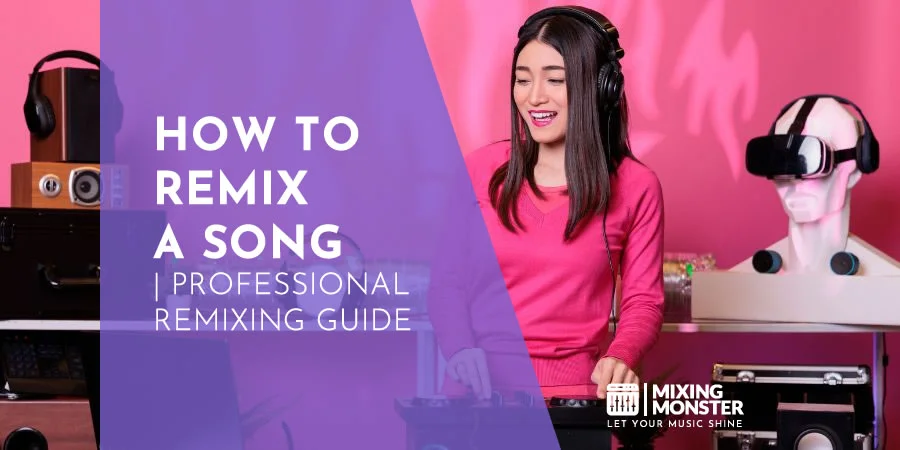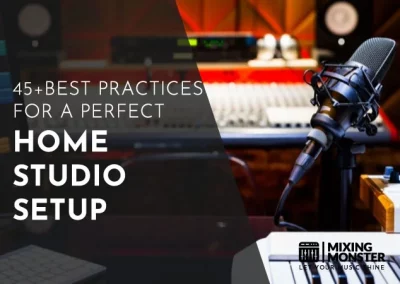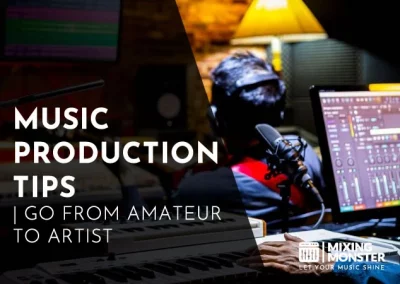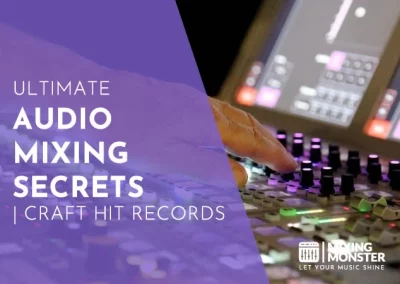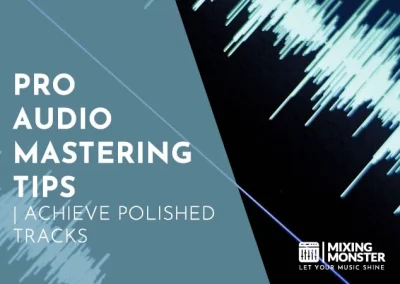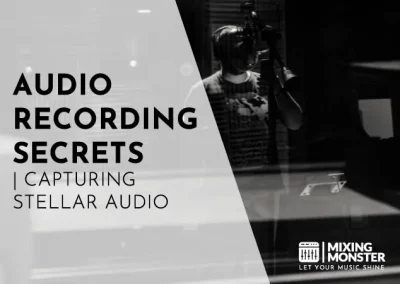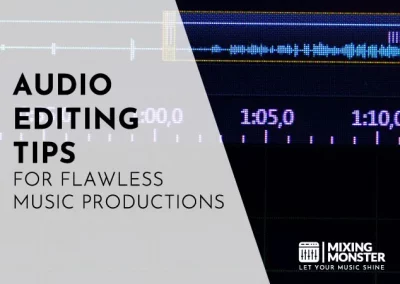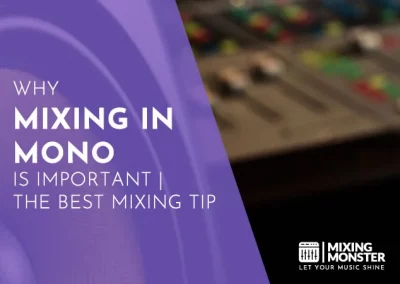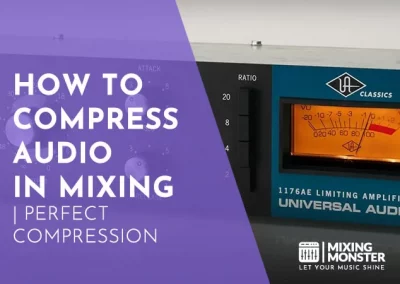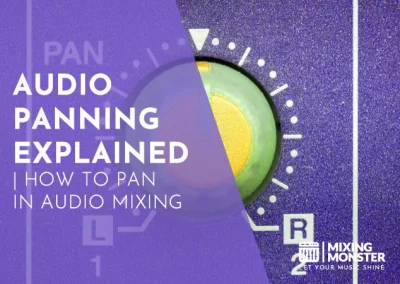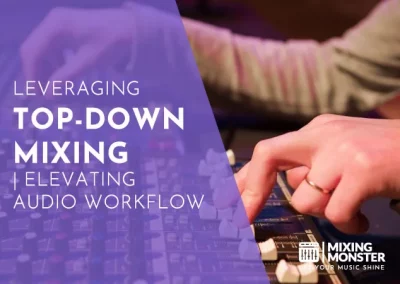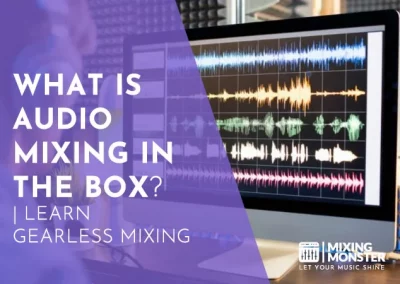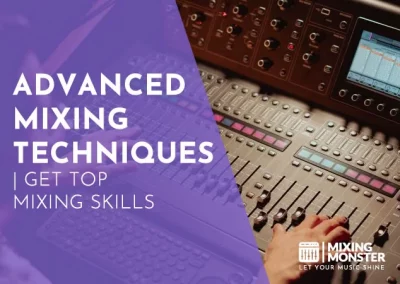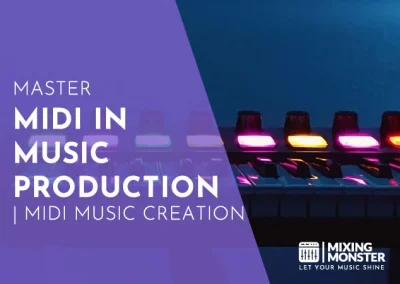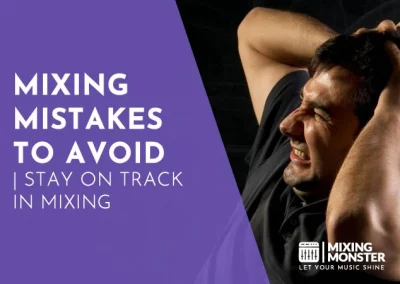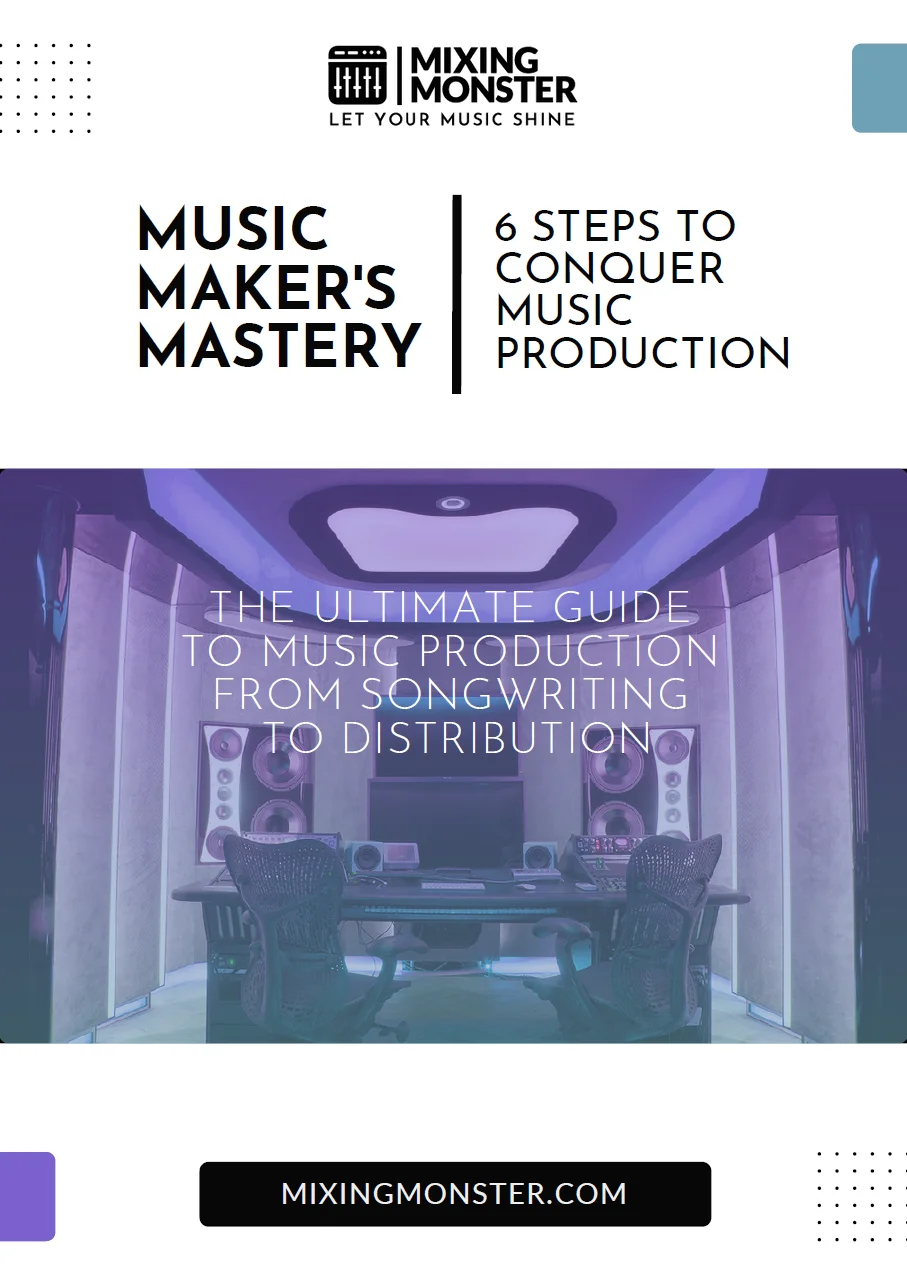Home > Blog > Mixing > Mixing Techniques
Disclosure: Some of the links below are affiliate links, meaning that at no additional cost to you, we will receive a commission if you click through and make a purchase. Read our full affiliate disclosure here.
Remixing a song bridges the gap between listener and creator, opening a portal to a new auditory experience. As a producer or artist, you can transform existing melodies and rhythms into something uniquely yours—a signature sound that resonates with audiences and furthers musical conversations. Learning how to remix a song requires a blend of creativity, technical skill, and a deep respect for the original work.
To remix a song, the artist or producer must reimagine the track while maintaining its essence. This involves understanding the original song’s structure, analyzing its stems, and deciding how to enhance or alter its components to produce a fresh sound—extracting vocals, instrumentals, and other sound elements using sophisticated audio software and equipment.
Embrace the journey of remixing as an opportunity to express your musical instincts and technical prowess. You can captivate listeners with your vision by selecting the right song, mastering remix tools, and adding your personal touch. As you progress through the intricacies of the remixing process, you will discover the means to craft a sound that resonates with your style and appeals to your desired audience.
KEY TAKEAWAYS:
- Remixing transforms existing music into inventive new tracks.
- Requires technical skills with audio software and a creative approach.
- Remixing involves selecting songs, understanding tools, and crafting a signature sound.
Table Of Contents
1. Understanding How To Remix A Song
2. Choosing The Right Song For Remixing
3. Audio Software And Equipment For Remixing
4. Working With Stems And Vocals In Remixing
5. The Remixing Process
6. Crafting Your Signature Sound
7. Mastering The Final Remix
8. Promoting Your Remix
9. Understanding the Evolution Of Remix
10. Collaborating And Networking In Remixing
11. Wrapping Up How To Remix A Song
12. FAQ

1. Understanding How To Remix A Song
Embarking on a remix project means you’re set to redefine an existing track by injecting your creativity while ensuring you stay within legal bounds.
A successful remix breathes new life into the original, offering a fresh perspective that resonates with audiences.
What Is A Remix?
A remix is when you take an original song and modify its elements—adding, removing, or altering—to create a new version that is distinct yet retains the essence of the original. This practice has become a staple in music production, transcending genres.
Overview Of How To Remix A Song
To start a remix:
- Obtain Stems Or Original Audio:
Acquire the original track’s stems or primary audio to work with. - Creative Direction:
Decide on your new take, be it a genre shift or a thematic twist. - Production Work:
Use music software to manipulate and reassemble the track’s components. - Add Your Signature:
Integrate your sounds and effects to personalize the remix.
Following these steps, you forge a bridge between the old and new, offering listeners a revamped musical experience.
History Of Remixes
Remixes date back to the late DJ culture of the ’70s and ’80s, where manipulating vinyl records was an art form. This led to the remix culture we know today, where electronic equipment allows more intricate revisions of music tracks.
Legal Considerations Of Remixing A Song
Before you begin, it’s critical to understand the legal implications:
- Permission:
Ideally, get consent from the copyright holder before remixing. - Usage Rights:
Determine what is legally permitted with the original content. - Copyright:
Remember that remixes can infringe upon the original artist’s rights if not cleared.
To avoid legal woes, always ensure you have the right to remix a track, which might involve agreements or obtaining a license.
2. Choosing The Right Song For Remixing
When you set out to remix a song, selecting the right track is as pivotal as any production technique you’ll use later. The genre and popularity of the original music, coupled with the legal permissions required, will significantly impact your remixing journey.
Analyzing Genre And Popularity
Your first step is to survey the song’s genre and popularity.
- Genre:
Each genre presents different challenges and opportunities. Electronic tracks offer more flexibility for manipulation, while a rock song needs more creativity to transform into a remix. - Popularity:
Trendy songs come with a pre-built audience and more competition. Alternatively, remixing a less-known track allows for greater creative freedom and potential to stand out.
Consider how the track fits within its genre and how the audience perceives it. Will it resonate with the crowd you’re targeting? Is the song’s key compatible with the remix you have in mind?
Obtaining Permission For Remixing
Before you dive into the production:
- Remix Contest:
Look for remix contests, which can be a golden opportunity to find songs where explicit permission is given to create and share a remix. - Permission:
If there’s no contest, you’ll need permission from the rights holders — usually the artist, record label, or both.
Remember, having proper permissions respects the original creator’s rights and ensures your remix can be published and shared legally. Keep documentation of your permission to safeguard your work.
3. Audio Software And Equipment For Remixing
Choosing the right audio software and equipment is a critical step in the remixing process. The digital tools you select will shape the creativity and quality of your work, whether you’re a novice or an experienced producer.
Exploring DAWs
Digital Audio Workstations (DAWs) are the cornerstone of music production, providing a comprehensive suite of tools for recording, editing, mixing, and arranging audio tracks.
Ableton Live is a popular choice for remixing due to its intuitive interface and robust features that cater to electronic music producers.
When selecting a DAW, ensure it supports the software and plugins you plan to use, offering a seamless workflow for your remixing projects.
Essential Remixing Plugins
Plugin selection can significantly enhance the remixing experience within your chosen DAW. Look for:
- EQs And Filters:
Sculpting the sound and fitting samples into the mix. - Compressors:
For dynamic control and adding punch. - Reverb And Delay:
To create space and depth.
Ableton Live users benefit from a vast collection of built-in plugins complementing the DAW’s capability. Still, third-party plugins can also offer unique and powerful options for achieving the desired sound in your remix.
4. Working With Stems And Vocals In Remixing
When remixing a song, you’ll typically work with stems and vocals to craft a new version. Stems are the individual parts of a track, such as the bass, drums, and keyboards. Vocal stems are the isolated vocal tracks from the song. Together, these elements give you the flexibility to reconstruct the piece creatively.
Isolating Vocal Tracks For Remixing
To remix a song effectively, you need to isolate the vocal tracks. This allows you to work with the artist’s original vocal performance without interference from other instruments.
Tools such as iZotope RX can assist in cleanly separating vocals from a mix.
You can adjust the timing, pitch, and effects with vocal stems to fit your remix vision.
- Process:
- Import the whole track into your DAW (Digital Audio Workstation).
- Utilize audio separation software to extract the vocals.
- Fine-tune the isolated vocals using EQ and compression.
Manipulating Instrument Sounds
Once you have your vocal stems, you can manipulate the instrument sounds to create a fresh backdrop. With the individual stems of instruments, your options for creativity are nearly limitless.
You can change the tempo, add effects, or introduce new sounds that complement the vocals. To manipulate instrument sounds, consider the harmonics, rhythm, and texture critical aspects of your remix.
Techniques:
-
- Change The Tempo:
Alter the BPM for a different vibe. - Add Effects:
Use reverb, delay, distortion, and other effects to transform the original sound. - Layer Sounds:
Introduce new instrument layers to enhance or contrast the original stems.
- Change The Tempo:

5. The Remixing Process
Remixing a song involves reimagining the original track through creative rearrangement and adding new elements. Consistency in structure and the innovative use of samples and effects are fundamental to breathing new life into a song.
Structuring Your Remix
Structure is vital in your remix; it dictates the flow and dynamics of your new creation. Begin by identifying the sections of the original track: the intro, verse, chorus, bridge, and outro.
Decide which parts you want to keep, modify, or remove. Your remix should have a clear progression that can often mirror the original, but feel free to play with the order to craft a unique journey for the listener.
Incorporating Samples And Effects In Remixing
Samples and effects are the building blocks that will distinguish your remix.
Utilize samples to inject new flavors, ranging from vocal snippets to instrumental hooks. Be sure to secure the rights to any samples you intend to use.
Effects such as reverb, delay, and distortion can alter sounds to fit the vibe of your remix. Apply them judiciously to enhance the textures without overshadowing the core elements of the track.
Step-By-Step Guide On How To Remix A Song
- Choose Your Song:
Please select a track that resonates with you, and you’re legally allowed to remix it. - Analyze The Original:
Listen carefully and note its structure and key elements. - Gather Your Tools:
Set up your digital audio workstation (DAW) with the necessary plugins and samples. - Extract The Parts:
Isolate the stems or samples you want to incorporate in your remix. - Create A Rough Layout:
Sketch out the basic structure of your remix. - Experiment With Elements:
Add, alter, or remove parts to create your rendition. - Apply Effects:
Enhance your remix with effects, but don’t rely on them solely. - Seek Creativity In Repetition:
Apply variations to create a captivating loop or sequence. - Mixing:
Balance the levels, panning, and EQ to ensure everything sits well together. - Mastering:
Apply final touches to the overall sound for a polished finish.
6. Crafting Your Signature Sound
Creating a signature sound involves a mix of innovation and technical skills in altering existing tracks. The goal is to imprint your artistic identity onto your remixes, making your work distinct and memorable.
Developing A Unique Remix Style
Your remix style should reflect a unique blend of influences and creative decisions that set you apart.
Start by identifying features of the genre you’re drawn to and think about how you can alter them to create something new. For example, if you’re remixing a house track, you might speed up the tempo or add unexpected acoustic elements to give it a personal twist.
Remember to experiment with different structures and sounds. Consistency in elements like tempo, rhythm, and your approach to drops can help establish your trademark style.
However, be careful not to be monotonous—variety within your style keeps listeners engaged and shows your versatility as a producer.
Using Synths And Melodies In Remixing
Synths are powerful tools for defining your sound, as they can be transformed limitlessly.
Dive into the synthesis process; tweak parameters like oscillators, filters, and envelopes to design sounds that listeners will associate with your music.
For melodies, take the time to learn the basics of music theory if you haven’t already. Understand how to construct memorable hooks and use harmonic structures to support the emotional character of your remix.
Combine catchy melodics with custom-patched synths to forge a sound that is yours alone. Crafting your signature sound as a remixer isn’t just about the final product but the journey of musical self-discovery.
Each decision you make—from the synths you program to the melodies you compose—builds your unique identity in music.
7. Mastering The Final Remix
Mastering your final remix involves a meticulous process to ensure you achieve both loudness and clarity, which are critical for standing out, especially in a remix competition. Your polished mix can only shine through proper mastering – the last step to prepare your track for distribution.
Enhancing Loudness And Clarity
Loudness: Your goal is to achieve a powerful sound without sacrificing quality.
Use a limiter with moderate settings to boost your mix’s overall volume while avoiding distortion. Please pay attention to the loudness units full scale (LUFS) as it has become the standard measurement for perceived loudness.
- Clarity:
Apply EQ adjustments to remove any muddiness and sharpen the frequencies of each instrument within your mix. - Strategic compression enhances dynamics, making your track punchier. Consider subtle multi-band compression if certain elements of your remix still don’t pop as they should.
Finalizing Your Remix For Distribution
File Formats:
WAV or AIFF are your best bets for lossless audio quality. However, if you’re constrained by file size, an MP3 at 320kbps can suffice.
Metadata:
Be thorough with your track’s metadata. Include the artist’s name, track title, and any collaborators. Remember that this information follows your remix across platforms.
Considerations for Remix Competitions:
If you’re submitting to a remix competition, double-check their submission criteria. Some contests may specify particular formatting or metadata requirements.
8. Promoting Your Remix
Once your remix is polished and ready, getting it in front of the right audience is crucial. Strategic promotion can greatly increase your reach and may lead to recognition from labels and influencers in the industry.
Using DJ Pools And Social Media
DJ pools are an excellent resource for promoting your remix to a community of professional DJs and music enthusiasts often looking for fresh tracks to play in their sets.
By submitting your remix to reputable DJ pools, you expose your work to a dedicated audience and stand a chance to get picked up by radio stations and club DJs.
To supplement this, actively engage with your fan base on social media platforms. Platforms such as Instagram, Twitter, and Facebook are powerful tools for promotion. Share clips, announce release dates, and interact with your followers to create a buzz around your remix.
Participating In Remix Competitions
Remix competitions present a unique opportunity to showcase your talent and get your work evaluated by industry professionals.
Keep an eye out for contests hosted by record labels or notable artists, as they often promote the winning remixes, which could lead to significant exposure. When participating, bringing your best work forward and adhering to the competition rules is essential.
Strive to present something that stands out and resonates with the audience and the judges. Winning or even ranking well can give your remix—and your profile as an artist—a significant boost.
9. Understanding the Evolution Of Remix
Remixing has transformed significantly through the decades, intertwined with technological shifts and cultural trends. In this section, you’ll uncover the critical role electronic music has played in the evolution of the remix and observe how remixes have adapted to cater to ever-changing musical tastes.
Influence Of Electronic Music On Remixing
The rise of electronic music precipitated a seismic change in how remixes are crafted. Synthesizers, drum machines, and digital audio workstations gave artists an unprecedented palette to reimagine tracks.
Early adaptations saw disco and funk tunes infused with electronic beats, creating a foundation that modern remixers continue to build upon. The interplay between original compositions and electronic remixes blurred lines, giving birth to entirely new genres and reshaping existing ones.
Adapting To Changing Tastes
As you navigate through the remix landscape, it becomes evident that adaptability is key. Remixes once served primarily to extend a song’s danceability for clubs but have since morphed to meet diverse listener preferences.
Contemporary remixers must be attuned to changing tastes, often introducing new rhythms or altering the song’s structure to resonate with their audience. Tools like Tunebat assist remixers by providing key and tempo information, enabling them to maintain musical coherence while putting their stamp on a work.
This responsiveness to the audience’s palate ensures that remixes remain a relevant and dynamic element of music culture.
10. Collaborating And Networking In Remixing
In remixing, connecting with other music producers and working with independent artists can dramatically increase the quality of your work. It’s about blending talents, using a Digital Audio Workstation (DAW) to its full potential, and expanding your musical horizons through shared ideas and networking.
Connecting With Other Producers
When aiming to produce a standout remix, tapping into the collective knowledge of other producers is invaluable. Networking can lead to new techniques, insights into your DAW’s capabilities, and potential collaborative opportunities.
Consider joining online forums, attending music production webinars, or engaging in social media groups tailored to music production. By actively participating in these communities, you’ll discover a wealth of information and make connections that could evolve into collaborative projects.
Remember, it’s not just about what you know but who you know.
Working With Independent Artists
Collaborating with independent artists is a mutually beneficial way to expand your remix repertoire. Send direct messages to artists whose work aligns with your style, or utilize platforms like SoundCloud to discover emerging talents.
When discussing potential collaborations, be clear about your intentions and how you aim to transform their original track within your remix. This transparency helps build trust and lays the foundation for a solid working relationship.
Moreover, working with independent artists exposes your remixing style to new audiences, thereby growing your fan base.
11. Wrapping Up How To Remix A Song
Before you embark on your final mix, ensure that all the elements of your remix reflect your unique style while preserving the essence of the original track. Your creativity in this phase determines the impact of your remix, so let’s solidify what you’ve learned.
The Art Of Remixing A Song
The artistry in remixing a song lies in balancing originality with familiarity. You have dissected the track, identified its core components, and injected your distinctive sound.
As you wrap up, pay close attention to the emotional flow and energy levels throughout your remix. Aim for sonic cohesion and an engaging progression that captures the listener’s attention.
Start Remixing Tunes!
With the foundational knowledge and practical tips you’ve accumulated, it’s time to begin your journey in remixing. Experiment with various elements and embrace the learning process. Remember, every attempt enriches your skill set.
Let’s summarize the key steps to remix a song:
| Step | Description |
|---|---|
| 1. Choose The Right Track | Pick a song that resonates with you and offers flexibility for creative expression. |
| 2. Isolate And Identify Elements | Separate the core elements like vocals, bass lines, and melodies you want to retain or modify. |
| 3. Create Your Signature Sound | Develop unique sounds and beats that align with your musical identity. |
| 4. Structure The Remix | Arrange the old and new elements to form a coherent and compelling musical narrative. |
| 5. Fine-Tune With Effects And Transitions | Utilize effects to enhance the texture and transitions to ensure seamless flow. |
| 6. Master Your Track | Apply mastering techniques to give your remix a professional, polished finish. |
As you deep dive into the process, you’ll cultivate your style and potentially captivate an audience eager for fresh takes on their favorite tunes.
Start remixing and make your mark on the music world.
Happy remixing!
12. FAQ
1) What are the best software tools for remixing songs?
Software such as Ableton Live, FL Studio, and Serato Studio are highly recognized for their comprehensive features for remixing songs. These tools offer a variety of sound effects and mixing options to create high-quality remixes.
2) What steps should beginners take to start remixing songs?
Beginners should start by analyzing the original track, understanding its structure, and identifying the parts they want to alter. It’s also crucial to learn the basics of your chosen software. A clear understanding of the music’s key, tempo, and rhythm is essential.
3) How can one remix a song using only a phone?
Using a phone to remix songs is feasible with apps like Groovepad and Remixlive. These apps allow you to work with sound loops, effects, and samples, offering a compact solution for remixing on the go.
4) Can someone legally create and share a remix of a song?
Creating and sharing a remix requires obtaining permission from the original copyright holders. Without proper authorization, you risk copyright infringement. Always seek legal clearance before distributing your work.
5) What apps allow the remixing of songs directly on a mobile device?
Apps like GarageBand for iOS and Edjing Mix for Android and iOS support on-the-go remixing. They provide a range of tools and effects to remix songs directly from your mobile device.
6) What are some tips for remixing songs specifically for dance purposes?
When remixing for dance, focus on maintaining a steady, driving beat. Also, consider the energy flow of your remix. Layering your track with rhythmic elements and transitions that build excitement can be very effective for dance music.

